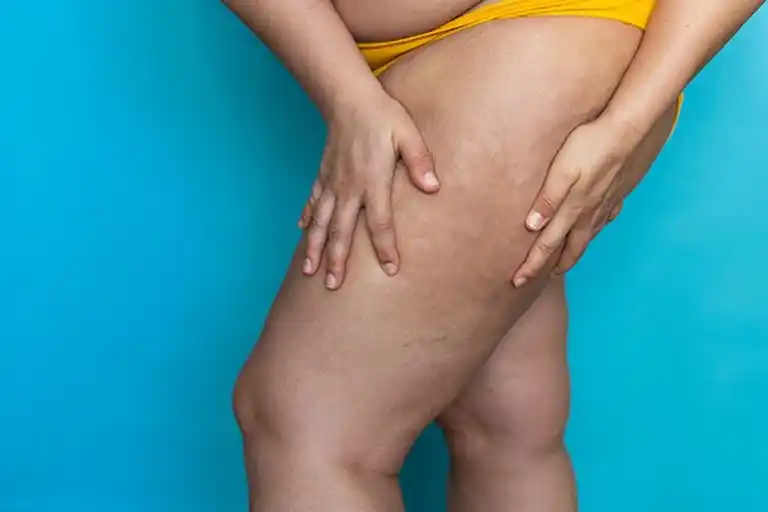Lipedema: Understanding the Condition and Its Impact
Explore the question ‘What is Lipedema?’ and gain insights into its causes, symptoms, and how this condition can affect your life. Find essential information here.”

What is Lipedema?
Lipedema might sound like a big, complicated word, but don’t worry; I’m here to explain it to you in simple terms. Imagine you have a friend named Lily. Lily is a little different from other kids because she has a condition called Lipedema.
B. Why is Lipedema Important?
Lipedema is a health issue that makes your body store extra fat in places like your legs and sometimes arms. Do you know how some folks put on weight in their belly or thighs? Well, in Lipedema, it’s more about the legs and arms, which can look a little swollen.
In this outline, we’re going to learn more about Lipedema. We’ll talk about what causes it, how it affects people, and what doctors can do to help. So, let’s dive in and explore this interesting topic!
Background of What is Lipedema?

A. Historical Context
Lipedema isn’t a new discovery. It has been known about for quite a long time. Let’s take a journey back in time and explore the history of this condition. There are also celebrities dealing with lipedema.
B. Prevalence and Incidence
Just how common is Lipedema? Let’s find out about the number of people affected by this condition and how often it occurs.
C. Demographics
Lipedema doesn’t pick and choose who it affects. It can happen to people from all walks of life. Let’s take a closer look at who is more likely to have Lipedema and why.
Causes and Risk Factors
A. What is Lipedema: Genetic Factors
Ever wondered why some people develop Lipedema? It turns out, that genetics play a significant role. Let’s explore how your family tree might be connected to this condition.
B. What is Lipedema: Hormonal Influences
Hormones are like little messengers in our bodies, and they can also have an impact on Lipedema. Let’s learn about the role hormones play in this condition.
C. What is Lipedema: Other Potential Triggers
Besides genetics and hormones, there might be other things that can trigger or worsen Lipedema. Let’s uncover some of these potential factors and understand how they come into play.

Clinical Presentation
Clinical Presentation’ in Lipedema. This fancy term simply means how Lipedema shows up in our bodies.
Lipedema is a condition where your body gives you hints that something might be wrong. Imagine if someone’s legs or arms look a bit different compared to the rest of their body like they don’t quite fit together. This can be a sign of Lipedema.
People with Lipedema might also feel uncomfortable or notice their legs or arms getting bigger. It’s like they’re swelling up in those areas. But strangely, their feet stay the same size. So, it’s like their legs or arms are puffy or swollen, but their feet don’t change. That’s what happens when someone has Lipedema.
Knowing these signs and symptoms is important because it helps doctors figure out and treat Lipedema. Think of “Clinical Presentation” as learning the hints that Lipedema gives in the body. It’s a bit like solving a puzzle to make sure people get the right help and start feeling better.
A. Symptoms
Lipedema brings about various symptoms, and these can differ from person to person.
- Fat Distribution Abnormalities Lipedema affects the way fat is stored in the body. Instead of being evenly distributed, fat tends to collect in certain areas, particularly the legs and sometimes the arms. This can result in those areas looking larger or swollen compared to the rest of the body.
- Pain and Tenderness People with Lipedema often experience pain and tenderness in the affected areas. This discomfort can vary in intensity, and it may be constant or intermittent.
- Bruising and Easy InjuryLipedema can make the skin more delicate, leading to easy bruising. Even minor bumps or knocks can result in visible bruises for someone with Lipedema.
- Swelling and EdemaSwelling, especially in the legs, is a common sign of Lipedema. Throughout the day, the swelling may worsen, making the legs appear puffy.
B. What is Lipedema: Stages of Lipedema

Lipedema doesn’t remain the same over time; it can progress through different stages. Doctors use these stages to describe the severity of the condition.
- Stage 1: Mild LipedemaAt this stage, the changes may not be very noticeable. The skin might still appear relatively smooth, and the pain may not be too severe.
- Stage 2: Moderate LipedemaIn this stage, the signs become more pronounced. The skin’s texture may change, and the discomfort can intensify.
- Stage 3: Advanced LipedemaThis is the most severe stage. Fat deposits become more significant, and the skin may become lumpy or nodular. Pain and tenderness are usually more intense, and there’s a higher risk of developing related complications.
C. What is Lipedema: Variations in Presentation
Hey there! It’s really important to know that not everyone who has Lipedema goes through the same things. Some people may have it worse than others, and the way it shows up can be different too. For some, it’s all about having extra fat build up in certain areas, while for others, it’s more about feeling pain and swelling.
And guess what? Lipedema doesn’t just affect one part of the body, like the legs. It can show up in other places too.
Why is this important? Well, doctors need to know all this stuff to help people with Lipedema. When they understand how it looks and feels for each person, they can figure out the best way to treat it. So, if you ever meet someone who has these symptoms, tell them to talk to a doctor. They can get the help and support they need to feel better.
Diagnosis: What is Lipedema?
So, you’ve learned about what Lipedema is and how it can affect people. But how do doctors figure out if someone has Lipedema or something else? That’s where diagnosis comes in.
A. Physical Examination
Doctors start by looking at and touching the areas where Lipedema might be happening. Imagine a doctor checking your legs and arms. They’re searching for specific signs like:
- Strange Fat Distribution: They notice if fat is collecting in an unusual way, making some body parts look different.
- Pain and Tenderness: Doctors ask if it hurts or feels sore when they touch those areas.
- Bruises and Easy Injury: They check if there are lots of bruises, even from small bumps.
- Swelling: Doctors see how swollen the legs or arms are, especially around the ankles.
This physical exam gives them some clues, but it’s not always enough to be sure.
B. Different Things to Think About
Sometimes, Lipedema can look like other things. Think of it like a detective trying to solve a mystery. They need to rule out other possibilities. Some conditions that can seem similar include:
- Lymphedema: This is when the arms or legs swell, but it’s for different reasons.
- Being Very Overweight: Sometimes, if someone is very overweight, it might look like Lipedema, but it’s not the same.
- Problems with Veins: If there are issues with the veins (the tubes that carry blood), it can also make legs swell. Doctors need to check if it’s not this issue.
C. Special Tests to See Inside
To be sure if someone has Lipedema, doctors use special tests to look inside the body. These tests include:
- Ultrasound: Like when you see a baby inside a mommy’s tummy, doctors use sound waves to make pictures. It helps them see what’s happening under the skin, especially in the swollen areas.
- MRI (Magnetic Resonance Imaging): This is like taking super-detailed pictures inside the body. It’s like a fancy camera for doctors.
- Lymphoscintigraphy: Big word, right? It helps doctors see how the lymphatic system is working. This can show if it’s really Lipedema or something else.
- Blood Tests: Sometimes, doctors take a little blood to check if there’s anything else causing the swelling.
By combining all these detective tools, doctors can figure out if it’s Lipedema or something else. Once they’re sure, they can start the right treatment to help the person feel better.

Impact on Quality of Life
Now that we know what Lipedema is and how doctors diagnose it, let’s talk about how it can affect a person’s life.
A. What is Lipedema and Physical Limitations
Imagine having Lipedema – your legs or arms might feel heavier, and it might be harder to move around. Simple tasks like walking or standing for a long time can be tiring. This can make it challenging to keep up with friends or join in on activities you enjoy.
B. Emotional and Psychological Effects
Lipedema doesn’t just affect the body; it can also affect how someone feels on the inside. You might feel self-conscious or unhappy about the way your body looks. This can lead to feelings of sadness or anxiety.
C. What is Lipedema and Social Implications
Lipedema can affect your social life too. It might make you avoid going to the pool or beach because you feel uneasy in a swimsuit. You might also hesitate to wear certain types of clothes. This can lead to you feeling excluded from social events or gatherings.
Lipedema can also affect your social life. It’s important to know that it doesn’t just impact your body; it can change how you see yourself and how you connect with others. That’s why it’s really important to be there for someone dealing with Lipedema, not just for their physical struggles but also for their feelings and emotions.
What is Lipedema: Treatment Options
So, what can be done to help someone with Lipedema feel better? There are several treatment options available, and they can make a big difference in managing the condition.
A. What is Lipedema: Lifestyle Modifications
Imagine making small changes in your daily routine to make life easier if you have Lipedema. These changes can include:
- Healthy Eating: Eating a balanced diet can help maintain a healthy weight and reduce the risk of additional fat accumulation.
- Regular Exercise: Gentle exercises like walking or swimming can improve circulation and reduce swelling.
- Compression Garments: Special garments can be worn to provide support to the affected areas and help with swelling.
B. Compression Therapy
Compression therapy involves using specially designed garments or wraps that apply pressure to the swollen areas. This pressure helps reduce swelling and discomfort. It’s kind of like giving your legs or arms a gentle hug to make them feel better.
C. Manual Lymphatic Drainage
Manual lymphatic drainage is a gentle massage technique performed by trained therapists. It can help improve the flow of lymphatic fluid and reduce swelling. Think of it as a soothing massage that encourages your body to get rid of excess fluid.
D. What is Lipedema: Medications
In some cases, doctors might prescribe medications to manage Lipedema symptoms. These medications can help reduce pain and inflammation.
E. Surgical Interventions
In more severe cases of Lipedema, surgery might be an option. There are different surgical procedures that can remove excess fat or improve the shape of the affected areas. Surgery is usually considered when other treatments haven’t provided enough relief.
F. Psychological Support
Remember how we talked about Lipedema not only affecting the body but also emotions? It’s important to get support for the emotional side too. Talking to a counselor or therapist can help someone cope with the emotional challenges that often come with Lipedema.
The right treatment approach often depends on the individual’s specific situation and the stage of Lipedema they’re in. It’s also important to remember that Lipedema is a chronic condition, meaning it might not go away completely, but proper management can significantly improve a person’s quality of life.
So, people with Lipedema have a variety of treatment options to choose from, and the goal is to find the combination that works best for them, making everyday life more comfortable and enjoyable.
Management and Coping Strategies
Living with Lipedema can be challenging, but there are ways to manage the condition and cope with its impact on daily life.
A. Patient Education
Imagine that you have a book full of information about Lipedema. Learning about the condition, its causes, and available treatments can empower individuals to take control of their health. Knowing what to expect can help them make informed decisions about their care.
B. Support Groups
Imagine joining a club where everyone understands what you’re going through because they’re experiencing it too. Support groups are like that club. They provide a safe space for people with Lipedema to share their experiences, seek advice, and find emotional support from others who can relate.
C. Self-Care Techniques
Self-care means taking time to look after your own well-being. For someone with Lipedema, self-care might include:
- Skin Care: Taking good care of the skin to prevent infections or irritations.
- Healthy Habits: Following a balanced diet and maintaining a healthy weight.
- Exercise: Engaging in gentle exercises to improve circulation and reduce swelling.
- Compression Garments: Wearing compression garments as recommended by the doctor.
D. Follow-Up Care
Think of follow-up care as regular check-ins with a healthcare team. This ensures that the treatment plan is working effectively and allows for adjustments if needed. It’s a bit like taking your car to the mechanic for a check-up to make sure everything’s running smoothly.
Regular check-ups with your healthcare provider are essential for managing Lipedema. During these visits, the doctor can:
- Monitor Progress: They’ll see how you’re doing and whether the treatment is helping.
- Adjust Treatment: If needed, they can make changes to your treatment plan to ensure it’s working optimally.
- Address Concerns: You can discuss any new symptoms or concerns with your doctor.
Remember, managing Lipedema is an ongoing journey, and follow-up care is like your roadmap to better health.

Current Research and Future Directions
Now, let’s talk about what scientists and researchers are doing to learn more about Lipedema and how they plan to help people in the future.
A. Current Research
Imagine scientists putting on their detective hats and working hard to understand Lipedema better. They’re conducting studies and experiments to figure out things like:
- Causes: They want to find out why Lipedema happens in the first place. Understanding the causes can help develop better treatments.
- Improved Diagnosis: Scientists are looking for better ways to diagnose Lipedema quickly and accurately so that people can start the right treatment sooner.
- Treatment Advances: Researchers are trying to come up with new treatments and improve existing ones to make life better for those with Lipedema.
B. Future Directions
Now, let’s look into the future. Scientists have big plans to make things even better for people with Lipedema:
- Personalized Treatment: Imagine getting a treatment plan that’s just right for you. Scientists hope to develop personalized treatments tailored to each person’s unique needs.
- Early Detection: In the future, doctors might be able to detect Lipedema even earlier, which means faster help for those who need it.
- Understanding the Role of Genetics: Researchers are exploring whether genetics plays a part in Lipedema. Learning more about this can open new doors for treatment.
- Support and Education: Scientists want to make sure everyone knows about Lipedema and has access to support and information. This way, people with Lipedema won’t feel alone, and they’ll know where to turn for help.
So, while Lipedema is a challenging condition, there’s a lot of hope on the horizon. Scientists and researchers are working hard to unlock its mysteries, improve treatments, and provide better support for those affected by it. In the future, people with Lipedema might have even more options to live healthier and happier lives.
Conclusion
Lipedema is a condition affecting fat storage, causing pain and swelling in areas like the legs and arms. Doctors diagnose it with exams and tests.
Living with Lipedema is tough, but treatments like therapy and surgery can help. Scientists are researching for better solutions, offering hope for the future.
Resources
Lipedema Foundation
(https://www.lipedema.org/): The Lipedema Foundation is a valuable resource for comprehensive information on lipedema. They provide articles, research updates, and educational materials for both patients and healthcare professionals.
National Institute of Arthritis and Musculoskeletal and Skin Diseases (NIAMS)
(https://www.niams.nih.gov/): NIAMS offers information on various musculoskeletal and skin conditions, including lipedema. You can find fact sheets, research updates, and resources for further reading.
Lipedema Society
(https://www.lipedemasociety.org/): The Lipedema Society, based in the United Kingdom, provides information about lipedema, support groups, and resources for patients. They also promote awareness and research.
PubMed
(https://pubmed.ncbi.nlm.nih.gov/): PubMed is a database of scientific articles and research papers. You can search for studies and articles related to lipedema to gain insights into the latest research findings.
WebMD Lipedema Overview
(https://www.webmd.com/skin-problems-and-treatments/lipedema-overview): WebMD offers an overview of lipedema, including its symptoms, causes, and available treatments.
Mayo Clinic
(https://www.mayoclinic.org/diseases-conditions/lipedema/symptoms-causes/syc-20374461): Mayo Clinic provides a detailed overview of lipedema, including information on symptoms, diagnosis, and treatment options.
American Academy of Dermatology
(https://www.aad.org/public/diseases/a-z/lipedema-overview): The American Academy of Dermatology offers an overview of lipedema, its symptoms, and available treatments.
Lipedema Project
(https://www.lipedemaproject.org/): The Lipedema Project is dedicated to raising awareness about lipedema and provides educational resources, including webinars and interviews with experts.
Lipedema Liposuction Center
(https://www.lipedemaliposuctioncenter.com/): This website offers information about lipedema, its diagnosis, and treatment options, including liposuction.
YouTube
(https://www.youtube.com/): You can find educational videos and personal stories about living with lipedema on YouTube. Many individuals share their experiences and tips for managing the condition.



